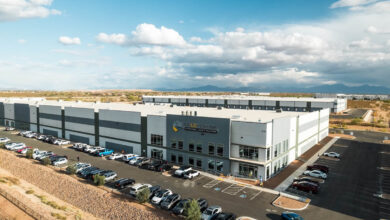
Raytheon Works to Build a Future Missile Defense System
No time to rest on laurels. The U.S. and its allies must keep an eye to the future, as rogue states continue to build new missile capabilities from land, at sea and in space.
“What used to be as simple as an outfielder throwing a ball, with a predictable and set trajectory, has now turned into a lot of balls going different directions at the same time – maneuvering, confusing, camouflaging. All of that is making the future of missile defense far more complex,” said Bryan Rosselli, vice president of Strategic Missile Defense for Raytheon Missiles & Defense, a business of Raytheon Technologies.
The best defense against such looming, catastrophic threats comes in layers – advanced sensors distributed on the ground, another layer in space, and in between a collection of next-generation effectors and a command-and-control system, or C2, pulling it all together and helping human operators make critical decisions.
Raytheon Technologies builds all that, and the company is bringing together its decades of experience and partnership with the U.S. Missile Defense Agency, U.S. Department of Defense and allied nations to help explore the demands for a modern missile defense system.
A traditional ballistic missile is predictable because its path is determined by velocity, momentum and gravity. Sensors detect a launch, track the missile’s trajectory across the skies and inform effectors to take it out in flight.
“We can’t take our eyes off the threats,” Rosselli said. “We must watch them in the boost phase all the way through midcourse down into terminal phase in order to understand and track their path as they move across the globe.”
The power of many
Distributed sensors across land, sea, air and space can be combined to provide a detailed picture that offers better tracking and discrimination of ballistic missile targets, while expanding the battlespace for engagement.
Bringing together radar beams of smaller sensors has the same effect as shining multiple flashlights on an object in the dark – a more detailed and more complete picture. It also makes the system more resilient, because distributed sensing isn’t dependent on a single monolithic radar.
“There is a need to add a more mobile distributed architecture that can see in 360 degrees and be adaptive to the various launch points or different directions threats may be coming,” Rosselli said.
Seeing threats only from the ground will not be sufficient in tomorrow’s missile defense system. Layered sensing means threat detection and tracking begins early – in space.
An early warning
Space is all about acquiring targets and then tracking them, said Wallis Laughrey, vice president of Space and C2 Systems at Raytheon Intelligence & Space, a business of Raytheon Technologies.
“Space gives you the ultimate high ground,” Laughrey said. “If you think of a hypersonic weapon launched from a site, there’s a large thermal signature that you can collect from space and track that target throughout its life.”
Future space architecture will likely be a hybrid of sensors, with the low Earth orbit, or LEO, constellation providing cueing. Once a threat is launched, it can be captured immediately and handed off to other space sensors to maintain the track and guide effectors.
“It’s very similar to what we do with our radars today in the infrared part of the spectrum, where you’re really watching heat and pushing those tracks around a global architecture in space,” Laughrey said.
Moving data quickly while tracking threats holistically from launch through flight is critical when dealing with threats that travel so fast and maneuver so capably.
“It’s how we’ll stay ahead,” Laughrey said.
A layered approach
Missile defense interception is constantly being improved. It has to be, as potential adversaries continue to develop new weapons.
“Your effectors have got to move faster. They’ve got to have extreme maneuverability to address these new threats,” Rosselli said. “And we must continue to become more sophisticated in our discrimination.”
Building a future missile defense system will require an evolution of existing interceptors, and developing new revolutionary technologies.
A future system should allow for multiple shots at any threat in flight, which drives a layered approach to engagement. Communication between the layers creates a stronger system that makes the most of the shots it takes.
To account for the unpredictable and fast nature of threats, non-kinetic engagement such as directed energy may also play a role.
“We need an affordable and rapid approach to adapt whatever we’re designing today to deal with something that might be out in 2030, 2040,” Rosselli said.
A way forward
It’s one thing to build a future system, but it’s another to deploy it. Research, development, collaboration, prioritization, and investment in people and tools are key. Moving fast is vital.
One way to accelerate future capabilities is to seek international co-development and system integration. Continually modifying regional architectures to extend across the globe will reduce gaps in coverage.
“Getting to an integrated system that has global sensor coverage at a much faster timeline than we have today is probably the most critical of everything that we’re dealing with,” Laughrey said. “We must be able to move at the speed of the threat.”





